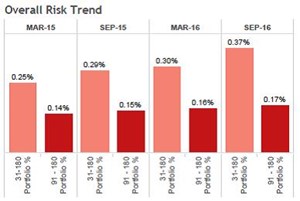Microfinance JLG sector going strong towards Rs 1 trillion Industry - Parijat Garg
The Microfinance JLG lending has grown by 17% in last 6 months and 97% over last 6 quarters. This soon-to-be a trillion rupee industry supports more than 4 crore borrowers across 620 districts with loans now averaging Rs 24000.
The extraordinary growth demands constant review of risks associated with repayment, over indebtedness and concentration.
Portfolio at Risk (PAR) 31-180 days continues to be low, though it has been on the rise over last 6 quarters – it has risen from 0.25% (Mar-15) to 0.30% (Mar-16) to 0.37% (Sep-16). Sharp increase has been observed in UP and Maharashtra. PAR may see further rise in near-term if the earnings are affected for borrowers as an effect of recent cash crunch.
 Only about 12% new borrowers have entered the system. 14% of existing borrowers service loans with 3 or more lenders. 34% of all overdue loans in top 10 states are with borrowers servicing loans with 3 or more lenders. With the leading NBFC-MFIs transforming themselves into Small Finance Banks over next few quarters, the number is expected to rise unless the regulatory guideline gets revised to include Banks and other NBFCs.
Only about 12% new borrowers have entered the system. 14% of existing borrowers service loans with 3 or more lenders. 34% of all overdue loans in top 10 states are with borrowers servicing loans with 3 or more lenders. With the leading NBFC-MFIs transforming themselves into Small Finance Banks over next few quarters, the number is expected to rise unless the regulatory guideline gets revised to include Banks and other NBFCs.
5 states of Tamil Nadu, West Bengal, Maharashtra, Karnataka and Uttar Pradesh still dominate with 57% share. 12% of portfolio is concentrated in areas around Bangalore-Mysore, Kolkata (Paraganas, Howrah, Hooghly), Pune, Nagpur-Amravati and Coimbatore. An external event such as borrowers being misguided on loan waivers post-demonetization in Nagpur and Amravati could negatively impact players, especially smaller ones, operating in the region.
The growth seems robust as there are no visible signs of risk as yet. Quicker adoption of technology will be instrumental to support growth, scale and efficiency. Recent demonetization will accelerate cash-less and digital transformation in the sector. Revision in regulation to include lenders other than NBFC-MFIs and continued self-discipline by lenders is needed to keep the sector distant from potential risks.
Source: Inclusive Finance Summit 2016, Summit Bulletin
